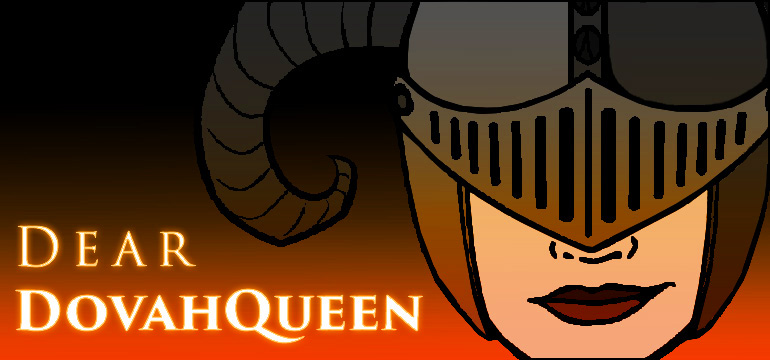The dungeon has been a classic staple of table-top gaming ever since people have been throwing d20s at character sheets, but has it outlived its usefulness? Today we discuss how to breathe life back into that traditional dungeon formula while keeping your players engaged.
Dear DovahQueen: I am running a campaign with PCs at level 5. How could I incorporate ecology and geology to the session so that it has the suspense of adventure without the dungeon crawl?—Dungeonable
Dear Lunchables: The idea of a dark dungeon full of monsters and treasure has been a staple of the game since day one. It has survived decades of edition and game changes because it’s become more a part of the gaming culture than of any particular game itself. And through all of this, the standard dungeon crawl remains widespread and still just as recognizable—rooms, corridors, traps, and monsters leading up to a boss fight and loot grab. Many GMs have ran as many of their own variations and flavors on this, but the basic formula is almost always the same. This is both the strength and weakness of the dungeon. It’s familiar, fun, and easy to run, but many roleplaying veterans may find that the dungeon formula just feels stale. In a way though, you almost lose something important to the game if you simply abandon the dungeon altogether. Injecting real-world ecology, geology, meteorology, and other Xologies is a strong way to take the classic formula and revitalize it. Let’s look at some basic components of a dungeon, pull them out of their element, and insert them back into the story outside of a dank, stone building.
Rooms in the dungeon are where we find things like monsters, treasures, traps, and big ole’ bad guys. When the players open the door, they have no idea to what dangers they are exposing themselves. There’s no reason though that this kind of suspense has to remain stationary. Consider a poisonous swamp and an abandoned wagon with canvas decayed into putrefaction blocking the only path through. Perhaps the heroes can’t go around with taking a dip in the mire which may be full of toxins, vermin, or both. And if a Bog Troll is hiding inside the wagon, then the heroes may have a surprise encounter. In this way, the encounter still serves much of the same purpose of one dungeon’s rooms in that it does funnel the heroes a certain way and exposes them to both known and unknown risks. Players have seen a wooden door with trolls on the other side of it more time than they can count so the change in locale and tone makes it feel fresh all again. You can even run multiple paths much in the same way your traditional dungeons lets players choose “right or left.” Taking these same elements and applying them to an environment without walls can do a lot to engage your players in the moment.
The environment’s ecosystem and climate themselves can really play a big part in helping to shape the way you design your hazards. By pulling your adventure out of the castle and putting it in the desert, themed traps and monsters will be easy to populate their journey with. Instead of the same ole arrow trap that players have triggered a million times, you can have them search for (and fail to find) quicksand from atop the dunes. Maybe there’s a dire antlion at the bottom waiting for lunch. Using monsters and traps from the environment is a really basic concept, but for some reason we don’t often think about structuring these adventures as we would a dungeon. Getting back to the basics is the best way to make the adventure feel new all over again. You could have a narrow pass which is the only way in and out of this desert. You could run quicksand traps, loose and falling rocks, collapsing caves, and crumbling ruins as traps. Interdunal areas, redoubts, watering holes, and rock formations can make for perfect rooms and corridors. Blistering heat, sandstorms, and freezing nights are perfect for general hazards to test their mettle. All of these are known staples to deserts and yet we never think about designing them into the adventure the same way we’d place a spike pit in from of the boss room. Deserts can be home to a very wide variety of monsters inspired by real desert counterparts like insects, scaled monsters, and hungry beasts. This can be applied to any environment you choose to create a fun adventure that has all of the mechanics of a fully rounded dungeon crawl.
But to really un-dungeon your adventure, you’ll want to consider running these things at least a few different locations (per adventure if possible). Maybe start your rooms, traps, monsters, and other hazards as the journey to whichever destination you need. For example, you could have the very first hazard be the furious blizzard that’s so cold characters become fatigued extremely quickly and risk semi-permanent damage unless they find shelter and appropriately pace themselves. At some point, switch it up. Have the forest trail lead up into the jagged mountains. Not only does this give a sense of distance to the adventure, but each clime is able to offer a different flavor with which to write your obstacles. In the end, you should be able to turn your standard dungeon with X rooms, Y traps, and Z monsters into a drawn-out adventure with X locations of interest, Y traveling hazards, and Z native monster.
Bonus points if the environment is dynamic and constantly changing.
Another small thing to consider that’s often overlooked is verticality. Tall towers aren’t exactly a new thing, but they rarely involve their height since floors tend to each contain their own neat little problems all wrapped up at once. Players know they can finish one floor and move on to the second. Consider making it less simple than that. Maybe a fight exposes a hole that allows the players to see down through the 15 floors that they just “finished.” Maybe even find a way for that to be relevant and a part of the adventure, rather than just a neat set piece or an arbitrary “don’t fall or it’ll hurt real bad.” Maybe the relic fell down and the villain jumped after it. Perhaps the they can now see a secret path through the ground floor some 100ft below them. Maybe they fell through the floor and have to climb the sheer walls while being peppered with arrows. A smaller enhancement to this is opening up a traditional dungeon crawl with exposed areas that can combine all of the elements mentioned above. Maybe the throne room should lead to a secret passage where the king is, but with the ceiling collapsed, and the torrential rain falling in, they’ll have a really hard time fighting his guards atop the rubble.
Again, bonus points and dynamics and such…
In the end, you should be able to run the same classic dungeon formula for all of its proven merits, but on a scale that involves a larger scope than the traditional castle’s basement. And, you using ecological and geological realities can really help you flesh out that adventure. This ought to keep a lot of the tried and true game mechanics that players look forward to while helping to make it fresh and fun again.
You can request RPG advice or send your questions by email to deardovahqueen@gmail.com or on Facebook.






